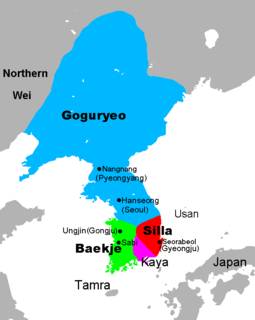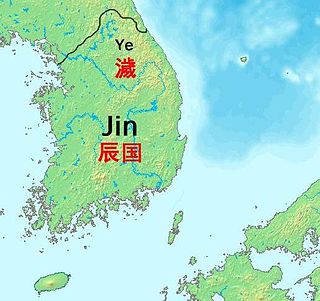There are various names of Korea in use today, all derived from ancient kingdoms and dynasties. The modern English name "Korea" is an exonym derived from the name Goryeo, also spelled Koryŏ, and is used by both North Korea and South Korea in international contexts. In the Korean language, the two Koreas use different terms to refer to the nominally unified nation: Chosŏn in North Korea and Hanguk in South Korea. Ethnic Koreans living in China and Japan also use the term Chosŏn to refer to Korea.

Buyeo, Puyŏ or Fuyu, was an ancient kingdom centred around the middle of Manchuria and existing as an independent polity from before the late 2nd century BC to the mid-4th century AD.

Gaya was a Korean confederacy of territorial polities in the Nakdong River basin of southern Korea, growing out of the Byeonhan confederacy of the Samhan period.

The Japonic or Japanese–Ryukyuan language family includes the Japanese language, spoken in the main islands of Japan, and the Ryukyuan languages, spoken in the Ryukyu Islands. The family is universally accepted by linguists and significant progress has been made in reconstructing the proto-language. The reconstruction implies a split between all dialects of Japanese and all Ryukyuan varieties, probably before the 7th century. The Hachijō language spoken on the Izu Islands is also included, but its position within the family is unclear. There is also some fragmentary evidence suggesting that Japonic languages may once have been spoken in central and southern parts of the Korean peninsula.

The Ryukyuan languages are the indigenous languages of the Ryukyu Islands, the southernmost part of the Japanese archipelago. Along with the Japanese language, they make up the Japonic language family. The languages are not mutually intelligible with each other. It is not known how many speakers of these languages remain, but language shift towards the use of Standard Japanese and dialects like Okinawan Japanese has resulted in these languages becoming endangered; UNESCO labels four of the languages "definitely endangered" and two others "severely endangered".

Peninsular Japonic languages are now-extinct Japonic languages that many linguists believe were formerly spoken in central and southern parts of the Korean peninsula. The evidence consists of placenames listed in ancient texts, principally the Samguk sagi.

The Goguryeo language was a Koreanic language spoken in the ancient kingdom of Goguryeo, one of the Three Kingdoms of Korea. The language is also known as Old Koguryo, Koguryoic, and Koguryoan.

The state of Jin was a confederacy of statelets which occupied some portion of the southern Korean peninsula during the 2nd and 3rd centuries BCE, bordering the Korean kingdom Gojoseon to the north. Its capital was somewhere south of the Han River. It preceded the Samhan confederacies, each of which claimed to be successors of the Jin state.

Samhan, or Three Han, is the collective name of the Byeonhan, Jinhan, and Mahan confederacies that emerged in the first century BC during the Proto–Three Kingdoms of Korea, or Samhan, period. Located in the central and southern regions of the Korean Peninsula, the Samhan confederacies eventually merged and developed into the Baekje, Gaya, and Silla kingdoms. The name "Samhan" also refers to the Three Kingdoms of Korea.
Khitan or Kitan, also known as Liao, is a now-extinct language once spoken in northeast Asia by the Khitan people. It was the official language of the Liao Empire (907–1125) and the Qara Khitai (1124–1218).

The Yayoi people were an ancient ethnic group that migrated to the Japanese archipelago mainly from the Asian continent during the Yayoi period. Radio-carbon evidence suggests the Yayoi period began between 1,000 and 800 BCE. They interacted, killed off and/or mixed with the remaining Jōmon people to form the modern Japanese people. Most modern Japanese people have primarily Yayoi ancestry.
The classification of the Japonic languages and their external relations is unclear. Linguists traditionally consider the Japonic languages to belong to an independent family; indeed, until the classification of Ryukyuan as separate languages within a Japonic family rather than as dialects of Japanese, Japanese was considered a language isolate.
Old Korean is the historical variety of the Korean language or Koreanic languages dating from the beginning of Three Kingdoms of Korea to the latter part of Later Silla, roughly from the fourth to tenth centuries CE.

The language of the kingdom of Baekje, one of the Three Kingdoms of Korea, is generally believed to have been a Koreanic language, related to the Sillan language.
The periodization of the historical stages of the Korean language is as follows:

The Koreanic languages are a language family consisting of the modern Korean language together with extinct ancient relatives.

Puyŏ, or Koguryoic, is a group of four languages of northern Korea and eastern Manchuria mentioned in ancient Chinese sources. The languages of Buyeo, Goguryeo, Dongye and Okjeo were said to be similar to one another but different from the language of the Yilou to the north and those of the Samhan to the south. Other sources suggest that the ruling class of Baekje may have spoken a Puyŏ language.
The geographically close Japanese and Korean languages share considerable similarity in typological features of their syntax and morphology while having a small number of lexical resemblances and different native scripts. Observing the said similarities and probable history of Korean influence on Japanese culture, linguists have formulated different theories proposing a genetic relationship between them, though these studies either lack conclusive evidence or were subsets of theories that have suffered large discredit.
Chapter 37 of the Samguk sagi contains a list of place names and their meanings, from part of central Korea captured by Silla from the former state of Goguryeo (Koguryŏ). Some of the vocabulary extracted from these names provides the principal evidence that Japonic languages were formerly spoken on the Korean peninsula. Other words resemble Korean or Tungusic words. Some scholars have ascribed the extracted vocabulary to an Old Koguryŏ language. Others, pointing out that the area concerned had been part of Goguryeo for less than 200 years, argue that these names represent the languages of earlier inhabitants of the area, and call them pseudo-Koguryŏ or Early Paekche (Baekje).










